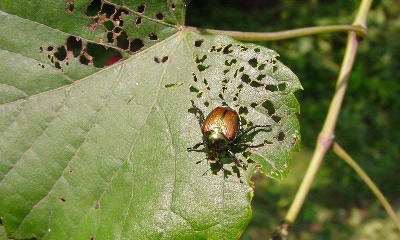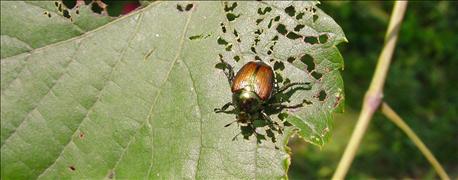
Japanese beetles are flying and feeding in corn and soybean fields across Missouri. University of Missouri Extension specialists warn farmers that the time to scout and spray is now.
Missouri Pest Monitoring Network put out several pest alerts for the Japanese beetle last week. Trap counts in the southwest corner of the state saw numbers as high as 5,600. And the beetle is on the move. Central Missouri traps saw counts from 3,000 to 6,000.
According to a MU Extension specialists, this year's Japanese beetle population appeared two weeks earlier than normal. The beetles began feeding on green corn silks and tassels, soybean leaves, and alfalfa forage. They are also damaging fruit trees.

Japanese Beetle (Chuck Bargeron, University of Georgia, Bugwood.org )
However, this is just the beginning.
More to come
Japanese beetle numbers are expected to peak in mid-July. "Two more full weeks of emerging beetles will play havoc," retired MU entomologist Ben Puttler says in a news release.
Currently, beetles are in the colonization stage in Missouri. Most rural areas will see increasing populations as the pest disperses and establishes itself throughout the state, Puttler says.
"There are no known natural enemies to reduce beetle populations in the state and none are on the immediate horizon," he adds.
What to look for
MU Extension horticulture and agronomy specialist Todd Lorenz monitors beetles in Cooper, Boone, Pettis and Howard counties and has seen numbers increase steadily in June. He says farmers should scout their fields now.
Adult Japanese beetles are metallic green in color with bronze- or copper-colored wing covers. They are about one-half inch long and have 12 white tufts of hair or bristles around the edge of the shell. Without magnification, these are seen as white dots.
Host plants develop a lacelike texture on leaves. The beetles damage corn tassels and developing silks, reducing yield. When the pest reaches its economic threshold, farmers should consider treatment.
Plan for treatment
Lorenz suggests applying an insecticide treatment to field corn during the silking period if there are three or more beetles per ear tip. Pollination should be less than 50%.
In soybeans, treatment is justified if foliage feeding exceeds 20% to 30% before bloom and 10% to 20% from bloom through pod fill. Use lower threshold numbers if plants are drought-stressed.
For more information from MU Extension on Japanese beetles, go to http://ipm.missouri.edu/pestMonitoring/jb.
About the Author(s)
You May Also Like






